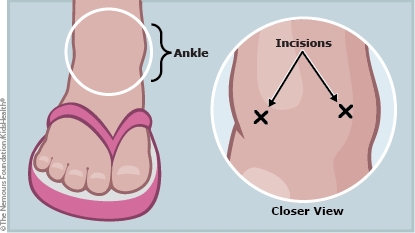After OCD Lesion Fixation of the Ankle: How to Care for Your Child
After surgery, your child will need to rest the ankle so it can heal. With the surgeon's supervision, your child eventually can return to normal activities.


An osteochondritis dissecans (OCD) lesion is a small area of damaged bone and cartilage that can become loose or detached from the rest of the bone. Your child has had surgery to repair an OCD lesion in the ankle joint. The surgeon secured the OCD lesion to the rest of the bone and removed some of the damaged tissue to help the area heal.
The goal of the surgery is to relieve your child's symptoms and help prevent the lesion from causing arthritis.

-
Give your child any medicines as prescribed by your health care provider.
-
Mild fever (less than 101.5°F [38.6°C]) is common in the first day or two after many surgical procedures. Your child's health care provider will give you advice about when to be concerned about a fever in the days after the procedure.
-
Do not remove the surgical dressings. The health care provider will remove them at your child's follow-up appointment.
-
To reduce swelling, elevate your child's leg above heart level on a pillow as often as possible for 2 days following surgery. If your child develops swelling, numbness, coldness, or tingling in the foot, loosen the bandage.
-
Apply a cold pack to the ankle as often as the health care provider instructs. Keep the bandage between the cold pack and skin.
-
While bathing, your child should hang the ankle outside the tub so it does not get wet. You should also cover the dressings with plastic wrap to protect them from splashing water.

-
If you haven't already, make a follow-up appointment with the surgeon.
-
Your child must use crutches for walking and must not put any weight on the foot. Follow your surgeon's instructions regarding wearing a brace.
-
Teens who drive may resume doing so once OK with the surgeon and no longer taking pain medication. Braces should be unlocked or removed before driving.

Your child:
-
Is unable to urinate (pee) by the evening of the surgery.
-
Develops fever over 101.5°F (38.6°C).
-
Has swelling or numbness in the foot that is not relieved by loosening the bandage and elevating the leg.
-
Has severe pain more than 48 hours after the procedure.
-
Has a lot of drainage from the surgical site.

Your child: